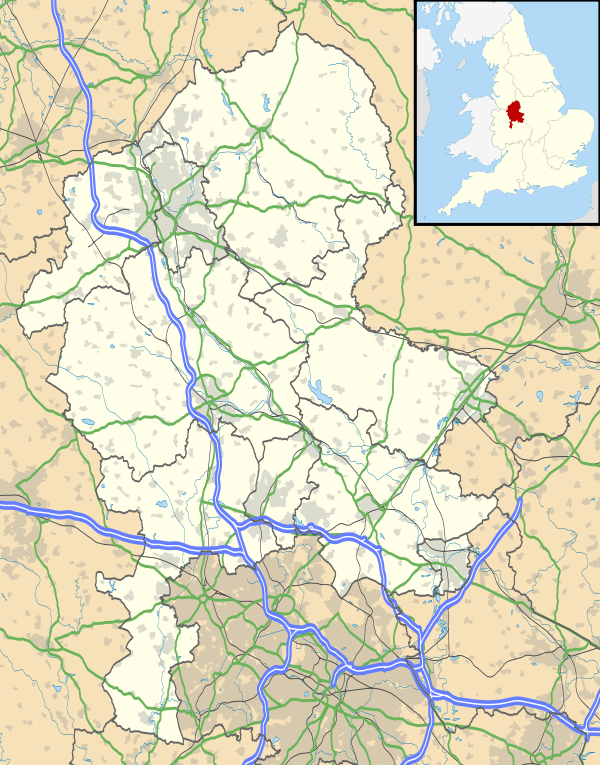Basford, Staffordshire
Coordinates: 53°01′10″N 2°12′45″W / 53.0194°N 2.2126°W
Basford is a bordering suburb of both Newcastle-under-Lyme and Stoke-on-Trent in Staffordshire, England. It is split between Newcastle and Stoke along the A53 – Etruria Road. It lies on high ground between the town centre of Newcastle-under-Lyme to its south-west, and Stoke's Etruria suburb (home to Festival Park commercial and retail development) to its east. Basford is also bordered to the north by May Bank, to its south by Hartshill, and to the west by The Brampton.
The suburb's busiest roads are Etruria Road, which features most of the area's businesses and the only local post office, Basford Park Road which leads to May Bank High Street and Wolstanton, and Shelton New Road which forms the southern boundary with Hartshill.
History
Basford's lofty position meant it was being referred to as "Basford Hill" or "Basford Bank" by the 1830s,[1] but previously (circa 1771) it had been called "Fowlea Bank".[2] The Fowlea Brook runs through nearby Etruria and has formed the valley. During the 1830s, the area featured typical ceramics industries; brick and tile yards.[3]
Culture
Basford is home to Europe’s first purpose-built[4] theatre in the round; the New Vic Theatre, which was built in 1986 to replace Hartshill's Victoria Theatre. Adjoining the New Vic Theatre is "Basford Villas", a modern development of four Italianate villa residences, which were inspired by The Villas in nearby Stoke-on-Trent.[5]
Sport
Basford Lawn Tennis Club was founded in 1883 and was originally sited on the present-day car park behind The Queen's Hotel, but moved to its present location of West Avenue in 1926. The club has several nationally ranked players and hosted an exhibition match between Fred Perry and 'Bunny' Austin on 11 May 1936.[6]
Recreation
The suburb features one public house on the Newcastle side of the area – The Polite Vicar, formerly the Georgian mansion Stoneyfields House. It opened as a pub in 1997.[7] Basford is also home to long-established roadhouse pub and later nightclub called The Queens. The building was built in 1769 as a mansion house for wealthy Derbyshire farmer Robert Emery.[8] Both venues are located on Etruria Road, but at June 2012 the Queens has been closed for some years.
To Haydon Street's east, there is a large tree edged playing field known as "Basford Open Space" which at 2012 is now called "Basford Park". The field was once the site of industrial works but has seen major reclamation and improvements including a paved cycle-path.
Between Victoria Street and Shelton New Road, is the large children's play area nicknamed "The Grum". It features a very large slide from the top of the grassy banks that surround the play ground, as well as swings, skate ramps and a basketball court. The Grum was once the entrance to a former railway tunnel, now long defunct. In Newcastle, garden allotments are used by local residents running east of Basford Park Road (at the end of Elm Street and Sydney Street).
Religion
The Church of England parish church of Basford is St. Mark's Church on Basford Park Road in the deanery of Newcastle-under-Lyme, Staffordshire.[9]
There is also a Seventh-day Adventist church on Victoria Street which was registered for worship in 1948.[10]
Basford had a Wesleyan Methodist chapel opposite St. Mark's Church on Basford Park Road. Built by 1902, it was demolished in the early 2000s and the site was redeveloped with apartments.
Literary associations
The writer H. G. Wells lived in Basford for a few months in 1888. The local industrial landscape made a strong impression, and he described it in his short story "The Cone".[11][12]
References
- ↑ "Stoke-upon-Trent - Buildings, manors and estates". British History Online. Retrieved 2010-09-29.
- ↑ "Stoke-upon-Trent - Buildings, manors and estates". British History Online. Retrieved 2010-09-29.
- ↑ "Stoke-upon-Trent - Buildings, manors and estates". British History Online. Retrieved 2010-09-29.
- ↑ "History of the New Vic theatre". New Vic Theatre. Archived from the original on 2007-09-28. Retrieved 2010-09-28.
- ↑ http://www.stokesentinel.co.uk/Turrets-stand-proud-home-unique-charm/story-13111557-detail/story.html[]
- ↑ "About Basford Lawn Tennis Club". Basford Lawn Tennis Club. Archived from the original on 11 October 2010. Retrieved 2010-09-28.
- ↑ "The Polite Vicar, Basford: The Cookman Review". This Is Staffordshire. Retrieved 2010-09-29.
- ↑ "Basford club The Queens thrives downturn". This Is Staffordshire. Retrieved 2010-09-29.
- ↑ "St. Mark's Church, Basford, Stoke on Trent". The Church Of England. Retrieved 2010-09-28.
- ↑ "Roman Catholicism and Protestant Nonconformity". British History Online. Retrieved 2010-09-29.
- ↑ Page 90 John R Hammond, A Preface to H G Wells, Routledge 2014. Accessed 12 May 2016.
- ↑ H. G. Wells writer stayed in this house during the year 1888. Open Plaques, accessed 12 May 2016.
External links
- Basford in the Domesday Book
